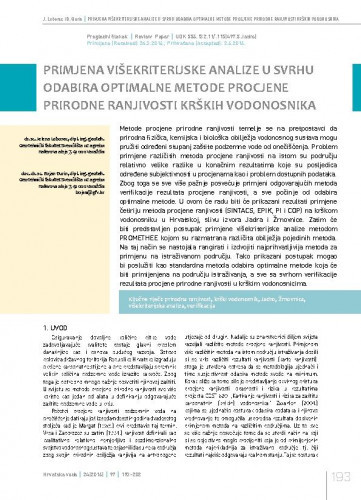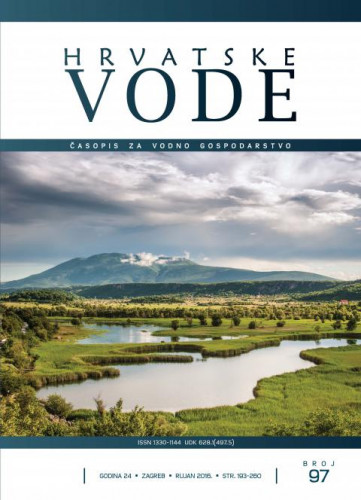Metode procjene prirodne ranjivosti temelje se na pretpostavci da prirodna fizička, kemijska i biološka obilježja vodonosnog sustava mogu pružiti određeni stupanj zaštite podzemne vode od onečišćenja. Problem primjene različitih metoda procjene ranjivosti na istom su području relativno velike razlike u konačnim rezultatima koje su posljedica određene subjektivnosti u procjenama kao i problem dostupnih podataka. Zbog toga se sve više pažnje posvećuje primjeni odgovarajućih metoda verifikacije rezultata procjene ranjivosti, a sve počinje od odabira optimalne metode. U ovom će radu biti će prikazani rezultati primjene četiriju metoda procjene ranjivosti (SINTACS, EPIK, PI i COP) na krškom vodonosniku u Hrvatskoj, slivu izvora Jadra i Žrnovnice. Zatim će biti predstavljen postupak primjene višekriterijske analize metodom PROMETHEE kojom su razmatrana različita obilježja pojedinih metoda. Na taj način se nastojala rangirati i izdvojiti najprihvatljivija metoda za primjenu na istraživanom području. Tako prikazani postupak mogao bi poslužiti kao standardna metoda odabira optimalne metode koja će biti primijenjena na području istraživanja, a sve sa svrhom verifikacije rezultata procjene prirodne ranjivosti u krškim vodonosnicima..; Methods for natural vulnerability assessment are based on the assumption that natural physical, chemical and biological characteristics of an aquifer system can provide some level of groundwater protection from pollution. The problem of the implementation of different vulnerability assessment methods in one area is due to relatively large differences in their final results as a consequence of certain subjectivity in assessments as well as dana availability. For these reasons, increasingly more attention is paid to the implementation of appropriate methods to verify the results of vulnerability assessments, which all starts out with the selection of an optimal method. This paper will present the results of the implementation of four vulnerability assessment methods (SINTACS, EPIK, PI and COP) to a Croatian karst aquifer, the basin of the Jadro and Žrnovnica springs. This will be followed by the presentation of implementation of the multi-criterial analysis procedure by means of the PROMETHEE method which took into consideration different characteristic of individual methods. In this manner, the attempt was made to rank and select the most acceptable method for the implementation in the investigated area. Thus presented procedure could serve as a standard method for selecting the optimal method to be used in the investigated area with the purpose to verify the results of the natural vulnerability assessment of karst aquifers.
Sažetak
Dio sveska

